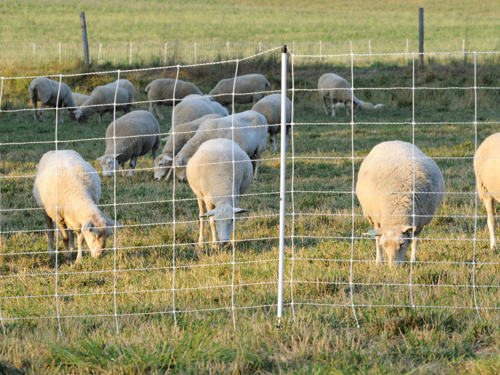Many folks find that their electric fences “stop working” when the soil becomes so dry that the grass turns brown.
Why does this occur?
Electric fences work by sending out an energy pulse that must return to the energizer for an animal to feel pain. The path of the pulse, for most fences, is:
- out through the insulated wire/netting—
- then through the animal nose/head/ears and out through the animals feet/paws to the soil—
- then down through moisture in the grass and soil to the damp subsoil and/or ground water deep under the topsoil—
- then through this moist, conductive path to the soil underneath the earth stake—
- then up the soil moisture under/around the earth stake–
- then through earth stake and ground wire back into the energizer.
Note that the pulse must travel via the moisture in the soil – twice. When the soil moisture is high enough to keep grass green then the total resistance of this circuit (in ohms) is low which allows more energy to pass through the animal—and usually cause animals enough pain to drive them away.
But as the soil moisture becomes less (and grass becomes brown) the resistance in the circuit increases (from 50 ohms to 500 ohms to 5000 ohms to 10,000 ohms) and much less energy passes through the animal. When absolutely no soil moisture is present (10,000 ohms and above) the soil has become an insulator instead of a conductor—even if the measured voltage exceeds 5000. The pulse’s path is blocked and the animal feels nothing.
What can be done to prevent or fix this? The options (not mutually exclusive to each other) are:
- Pray for rain. If this works for you, then please write to us immediately. If you are willing to travel you may never have to worry about employment! Regrettably it seems not to work for most folks.
- Add earth return wire(s) to your fence. An earth return wire is connected directly or via a long ground stake to the ground stake of your energizer. The animal must touch 2 wires the extra earth return one and the existing positive one that’s connected to the fence terminal) to feel a pulse—but when this occurs the probable pain will turn most animals. This system is particularly effective for large species (cattle, bear, horses) but will also work for sheep and goats if there are enough negative (earthed) and positive (connected to the energizer) wires. Earth return wires can be done as an offset wire from existing energized fences or the existing fence can be earthed and the offset wire is then energized (positive).
- Build strong wire fences that are physical barriers that don’t rely solely upon electricity to stop animals. All permanent fences at Premier are physical barriers with energized offsets because they work equally well when the ground is wet, bone-dry and/or covered with snow (which can be an insulator).
- Purchase wide impedance energizers instead of low impedance units. Low impedance units work well when the grass is green and the resistance (very similar to impedance) but their ability drops rapidly as soil becomes dry. Wide impedance units (the phrase is Premier’s) are more capable of pushing electric pulses through drier soils. The difference in effectiveness between the 2 energizers can’t be seen when the grass is green—but as it becomes dry and brown the difference to animals is dramatic. Interestingly, the difference between the 2 energizer types is not readily detected with a digital fence voltmeter unless you lay the ground portion of fence probe on the dry soil vs. pushing it into the soil or touching a steel post. Remember that animals don’t have steel spikes on their paws/hooves.
- Make the soil around and under the energizer’s ground stake as wet as it possible. Doing this reduces the resistance of the total fence circuit and enables a stronger electric pulse to travel through the animal. There are 3 ways to do this:
- Install a longer (e.g. 6 ft instead of 3 ft) ground stake. The extra length reaches deeper into the soil and thus reaches closer to damp subsoil and/or ground water
- Install the energizer’s ground stake where the soil is more likely to remain damp.
- Make a very small hole (size of a pencil lead) into the base of a 3 – 5 gal. bucket. Set it next to your energizer’s ground stake. Fill the bucket with water— and refill it daily. The water will gradually leak out and seep into the soil around the ground stake—and progressively make the subsoil wet around and beneath the ground stake. This works as well as a very long ground stake.
Taken from Premier’s Aug/Sept 2012 Newsletter.




